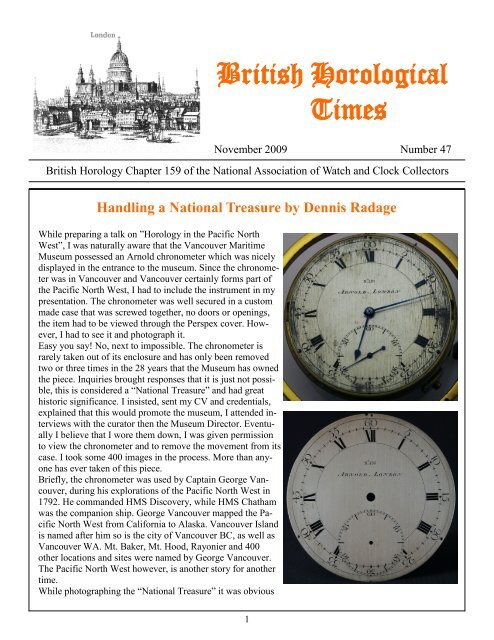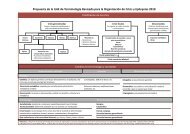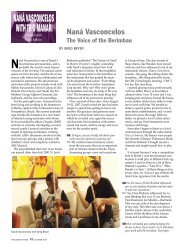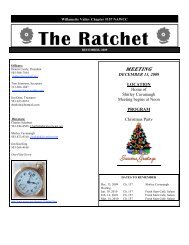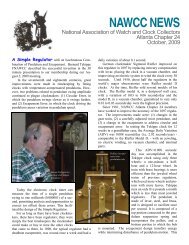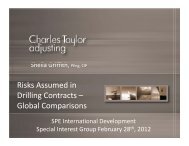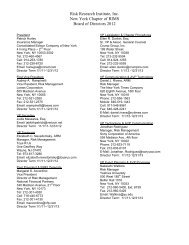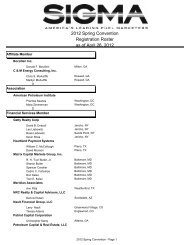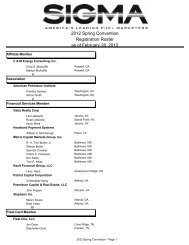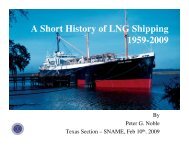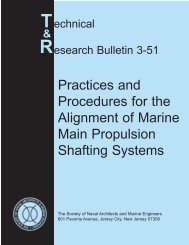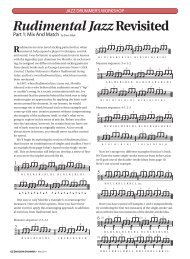British Horological Times - Amazon Web Services
British Horological Times - Amazon Web Services
British Horological Times - Amazon Web Services
You also want an ePaper? Increase the reach of your titles
YUMPU automatically turns print PDFs into web optimized ePapers that Google loves.
<strong>British</strong> <strong>Horological</strong><br />
1<br />
<strong>Times</strong><br />
November 2009 Number 47<br />
<strong>British</strong> Horology Chapter 159 of the National Association of Watch and Clock Collectors<br />
Handling a National Treasure by Dennis Radage<br />
While preparing a talk on ”Horology in the Pacific North<br />
West”, I was naturally aware that the Vancouver Maritime<br />
Museum possessed an Arnold chronometer which was nicely<br />
displayed in the entrance to the museum. Since the chronometer<br />
was in Vancouver and Vancouver certainly forms part of<br />
the Pacific North West, I had to include the instrument in my<br />
presentation. The chronometer was well secured in a custom<br />
made case that was screwed together, no doors or openings,<br />
the item had to be viewed through the Perspex cover. However,<br />
I had to see it and photograph it.<br />
Easy you say! No, next to impossible. The chronometer is<br />
rarely taken out of its enclosure and has only been removed<br />
two or three times in the 28 years that the Museum has owned<br />
the piece. Inquiries brought responses that it is just not possible,<br />
this is considered a “National Treasure” and had great<br />
historic significance. I insisted, sent my CV and credentials,<br />
explained that this would promote the museum, I attended interviews<br />
with the curator then the Museum Director. Eventually<br />
I believe that I wore them down, I was given permission<br />
to view the chronometer and to remove the movement from its<br />
case. I took some 400 images in the process. More than anyone<br />
has ever taken of this piece.<br />
Briefly, the chronometer was used by Captain George Vancouver,<br />
during his explorations of the Pacific North West in<br />
1792. He commanded HMS Discovery, while HMS Chatham<br />
was the companion ship. George Vancouver mapped the Pacific<br />
North West from California to Alaska. Vancouver Island<br />
is named after him so is the city of Vancouver BC, as well as<br />
Vancouver WA. Mt. Baker, Mt. Hood, Rayonier and 400<br />
other locations and sites were named by George Vancouver.<br />
The Pacific North West however, is another story for another<br />
time.<br />
While photographing the “National Treasure” it was obvious
Officers and Editor of<br />
<strong>British</strong> Horology Chapter 159<br />
Ken Johnston, President<br />
2006 Williamson Drive<br />
New Bern NC 28562-9178<br />
Phone 252-635-6431<br />
horology@suddenlink.net<br />
Dennis Radage, Vice President<br />
2515 Marine Drive<br />
West Vancouver BC<br />
Canada V7V 1L5<br />
radage@telus.net<br />
Julie Kern, Secretary<br />
5 Hilltop Drive<br />
Manhasset NY 11030-3411<br />
Phone 516-627-1012<br />
julienm@optonline.net<br />
David Kern, Treasurer<br />
5 Hilltop Drive<br />
Manhasset NY 11030-3411<br />
Phone 516-627-1012<br />
dkern@optonline.net<br />
Deena Mack, Editor<br />
644 Geise Road<br />
Attica NY 14011-9514<br />
Phone 585-591-1343<br />
dmack18@rochester.rr.com<br />
<strong>British</strong> Horology <strong>Times</strong> - BHT<br />
Is a newsletter of <strong>British</strong> Horology Chapter<br />
159 of the National Association of<br />
Watch and Clock Collectors.<br />
.<br />
BHT is published 3 times yearly.<br />
Editor : Deena Mack<br />
Correspondence and manuscripts should be<br />
sent to the Editor.<br />
Applications for membership and payments<br />
of dues should be sent to the Treasurer.<br />
Annual membership costs: USA $5.0<br />
Canada $5.0<br />
Overseas $6.0 in US funds or equivalent.<br />
Opinions expressed in articles in this newsletter<br />
are those of the writers and are not<br />
necessarily endorsed by the Chapter and/or<br />
by the newsletter and/or by the National<br />
Association.<br />
© Copyright 2009 by <strong>British</strong> Horology<br />
that this chronometer had not been well protected or serviced for<br />
some 30 years. Things were degrading and the dial particularly,<br />
the piece that most visitors see, was oxidizing badly, becoming<br />
almost illegible. I suggested that the dial should be stabilized using<br />
appropriate conservation techniques. I was asked to give a<br />
written proposal that the board could read so as to consider such<br />
action.<br />
Well, how do you conserve a National Treasure, a one of a kind?<br />
How should it be handled? How should this be done without using<br />
any mechanical mean? Re-silvering was out of the question.<br />
I contacted some associates from the Antiquarian <strong>Horological</strong> Society<br />
in England, who also happen to be curators, specialists at<br />
the Royal Observatory and National Maritime Museum in Greenwich.<br />
They were very interested in this project and were free with<br />
their advice. I was allowed to remove the dial and take it to my<br />
workshop. Following the advice I cleaned the dial then gave several<br />
coats of lacquer so as to protect the dial and prevent further<br />
degradation, at least for the next few years.<br />
I was a little anxious! What if I damaged or lost the dial? What if<br />
things went wrong. Fortunately all went according to plan and the<br />
dial was re-installed within the week. Included are the before and<br />
after dial images and an image of the movement showing one of<br />
John Arnold‟s compensating balances, a gold alloy helical balance<br />
spring and of course a spring detent escapement. The chain<br />
fusee and maintaining power can also be seen.<br />
In the months ahead I plan a more comprehensive article telling<br />
more of George Vancouver‟s exploits, other timepieces that were<br />
used on his voyages and of course much more on the chronometer<br />
in the Vancouver maritime Museum. \<br />
Note: For those on the internet, here is the address to the museum’s<br />
webpage: www.vancouvermaritimemuseum.com<br />
2
President‟s Message: 2010 promises to be an<br />
exciting year for Chapter 159. We will have interesting presentations<br />
at our meetings by internationally regarded speakers<br />
(well two out of three – I will do the third), then in August<br />
we are sponsoring a tour to England and Scotland. I<br />
tried to get the word out to all by email but I know not all<br />
have an address and I got a disappointing number of returns<br />
on my current list. In case you have not heard the tour is<br />
from August 23rd to September 6th. We start in London<br />
(Clockmaker‟s Company collection, <strong>British</strong> Museum and<br />
Belmont House). Travel to Scotland via Bletchley Park and<br />
Upton Hall (home of the BHI) where we will spend four<br />
days viewing historic Castles, a few collections and also a<br />
whisky distillery of course. Returning south we will stop off<br />
at Birmingham for a watch and clock fair, ending up at a<br />
Hotel near LHR ready for the trip home. I would like to<br />
thank Roger Gendron who initiated the whole thing and will<br />
be coming but wants to take a back seat. Jim Nicholls<br />
(jmn427@aol.com) who is looking after the finances and<br />
Editor‟s Corner: The National Convention is now a<br />
fleeting memory. Yes, I was there once the Custom agents<br />
decided I was no threat to national security and released us<br />
from the Canadian border. Everyone said, “Drive across<br />
Canada, it‟s faster!”. Maybe in miles but definitely not in<br />
hours spent traveling from New York to Michigan. Needless<br />
to say, on my way home I drove down and around Cleveland<br />
Ohio instead. Oh well, I am glad to see Homeland security<br />
being thorough. I saw many of our Chapter 159 members. It<br />
was great to meet in person, and be able to put a face with<br />
the name. <strong>British</strong> Horology was represented at a table in the<br />
Mart room. Dennis brought a table full of material for all to<br />
enjoy. While I did not come home with an English clock, I<br />
had a wonderful time anyway. To be honest, I bought a neat<br />
little German pendulum clock, and a one of a kind neon electric<br />
clock. It was made by a gentleman that has a shop in<br />
Grand Rapids. The local paper did a feature article on him<br />
and he had a table in the Mart room. It hangs on the wall of<br />
my shop and is a great souvenir of the convention. At the<br />
August Eastern States regional in Syracuse NY I was lucky<br />
enough to pick up an old volume named The Old Clockmakers<br />
of Yorkshire , written by N.V. Dinsdale. It was written<br />
and published in 1946 and I will feature an excerpt in this<br />
newsletter (see page 7). While the 41 pages of clockmakers<br />
listed in this little book could not compare to Loome‟s volume<br />
YorkshireClockmakers containing over 2000 names, it is<br />
2010 Program Schedule: <strong>British</strong> Horology<br />
Chapter 159 meets three times a year, at the Florida Regional,<br />
at the Southern Ohio Regional and at the National.<br />
The program schedule for 2010 is as follows:<br />
Florida Regional, January 15 – 16:<br />
“My Favorite Clock” by Dennis Radage, See page 7<br />
Southern Ohio Regional, April 8 – 10:<br />
“A Clay Musical Clock” The story of a clock that was presented<br />
to Caroline of Ausbach, the Queen Consort of George<br />
II, in 1736 and is now in the Colonial Palace of North Caro-<br />
3<br />
Philip Priestley (LINCOLNUK@aol.com) who is doing all<br />
the ground work in the UK. If you need more information<br />
please do not hesitate to get in touch with these gentlemen or<br />
myself (horology@suddenlink.net) for more details as we<br />
still have one opening.<br />
One of our members Fred Burgess died in Kissimmee, Florida<br />
on October 31st. Fred was very active in Newark, upstate<br />
NY for many decades and only recently moved to Florida.<br />
I first met Fred in 1996 during the Chapter 13 tour of the<br />
UK. Fred was the President of Chapter 13 and the sponsor of<br />
the tour while Philip Priestley was the organizer in the UK.<br />
On these occasions you tend to build lasting relationships,<br />
and so it was in this case. Fred had a constant battle with his<br />
health that took a turn for the worse at the Portland National<br />
Convention in 1998, but he never complained and joined us<br />
for yet another tour in England just two years ago. We will<br />
all miss Fred and offer his wife Ann and his family our condolences.<br />
Ken Johnston. \<br />
interesting read. My big purchase in Syracuse has nothing<br />
what so ever to do with <strong>British</strong> horology, but is fascinating<br />
all the same. It is some sort of a recording clock from the late<br />
1800‟s or early 1900‟s. I haven‟t solved the mystery yet, but<br />
it appears to contain some sort of apparatus for recording<br />
information. It<br />
stands 6‟ tall with a<br />
Seth Thomas balance<br />
wheel movement<br />
which connects to a<br />
recording mechanism<br />
and 2 spoke<br />
wheels to take up a<br />
paper tape located in<br />
the trunk of the case.<br />
I hope to be able to<br />
feature the clock in<br />
an upcoming article<br />
in our NAWCC Bulletin.<br />
Here is a<br />
photo. If you can tell<br />
me anything about<br />
what this it may be,<br />
I‟d love to hear from<br />
you. Deena. \<br />
lina.” by Ken Johnston<br />
2010 National in York PA June 16 – 20:<br />
“Captain Cook, Venus and a Great Discovery” by Philip<br />
Priestley<br />
If you are planning to attend the National or any of the above<br />
two Regionals, be sure to attend the <strong>British</strong> Horology Chapter<br />
159 meeting so as not to miss any of these great presentations.<br />
We look forward to seeing you there.<br />
Dennis Radage. \
More on Money by Tom Spittler<br />
I enjoyed the facts presented on the <strong>British</strong> monetary system in our spring newsletter<br />
and a few stories came back to me that I wanted to relay to our readers. Notice I<br />
said „stories‟ as I‟m not sure they have any real basis in fact and they should not be repeated<br />
as they may not be correct. Both the money stories were told to me in pubs, one<br />
in Wales, and one in Ireland. The third story concerns the <strong>British</strong> Imperial system of<br />
liquid measurement.<br />
I had just arrived in England and was having trouble understanding the old system<br />
of money when a very smart fellow in Wales explained to me the historic, ancient,<br />
relationship between gold and silver and its basis on coinage for over 2,000 years. Gold<br />
was considered to be 20 times more valuable than silver. By the 18th century the <strong>British</strong><br />
gold pound coin was worth a “Pound Sterling” or “a pound-of-sterling-silver.” By<br />
weight here were 20 Troy ounces in a pound (weight) and 20 <strong>British</strong> shillings, weighing<br />
a Troy ounce each, equaled in value the gold pound coin. (I remember asking what a<br />
Troy ounce was, but he didn‟t know). All other <strong>British</strong> gold and silver coins were<br />
marked off that standard, as well as the American colonial coins.<br />
When the American colonies got their independence, they made the $5.00 gold<br />
coin equal in weight to the <strong>British</strong> gold pound coin and they made 20 silver American<br />
quarters equal to the $5.00 gold coin. Thus the American quarter equaled a <strong>British</strong> shilling.<br />
The Canadians, as Doug Cowan mentioned, did the same thing and $5.00 Canadian<br />
equaled one <strong>British</strong> pound.<br />
As time went by, everyone put less gold and silver in their coins, but kept the<br />
ratio of 20 to 1, silver to gold, the same, until, and I‟m not sure who did it first-but lets<br />
say it was the Americans in about 1932-all these countries went off the gold standard<br />
and in about 1964, the Americans went off the silver standard. The end of story one.<br />
The second story was related to me on my first and only trip to Ireland when I<br />
was in an Irish pub and a very smart Irishman told me why there was a pound worth 20<br />
shillings and a guinea worth 21 shillings. He explained it had to do with business transactions<br />
and betting.<br />
Let‟s say a gentlemen went to an estate agent to sell some land. They agreed the<br />
land was worth 100 pounds and that is what the gentleman would receive for it. The<br />
estate agent would sell it for 100 guineas, take out the 5% difference, and give the gentleman<br />
100 pounds. The 5% was considered the fair cost of doing business.<br />
A second example has two equal horses in a match race with 1 to 1 odds. A<br />
bookie would take bets in guineas and pay off in pounds, again the 5% was the bookies<br />
profit. The same thing happened at auctions. Goods were sold in guineas and consignors<br />
were paid off in pounds.<br />
Now for another story, this one about <strong>British</strong> liquid measures and nothing to do<br />
with money, but it does involve alcohol. I had a physics professor in college who explained<br />
that the French changed their system of measure after the French Revolution and<br />
their measure of beer, the litre, was larger than the existing <strong>British</strong> quart, which is the<br />
same quart we in American use today. King George III was alarmed when he found out<br />
the French got more beer in their glass than the English and he converted he <strong>British</strong> system<br />
of liquid measure to the Imperial system and the new quart was larger than the<br />
French litre. The American stuck with the true <strong>British</strong> system of measures and today the<br />
<strong>British</strong> use the French metric system, although they don‟t like to be told so. What do<br />
YOU think? \<br />
4<br />
From the top:<br />
Half Crown<br />
George VI 1938<br />
Penny<br />
George V 1929<br />
Half Penny<br />
Elizabeth II 1962<br />
3 d<br />
George V 1918
A case for a thirty hour movement by Roger Gendron<br />
At our SOR meeting in 2008 Roger Gendron<br />
had some fine photographs of a tall case he had<br />
made for a thirty hour movement and his stand<br />
up presentation sparked a lively dialogue. The<br />
case looked wonderful and I am very grateful<br />
to Roger for bringing it to our attention. For<br />
those unable to attend, here are some of the<br />
photographs. KJJ. \<br />
5
Murday Balance Wheel Clock<br />
John Thomas Murday was an electrical engineer who<br />
became interested in designing and making clocks. He<br />
took several patents but made little or no impact with his<br />
pendulum clocks and so, prior to 1912, he turned to designing<br />
a balance wheel clock. About 300 of these balance<br />
wheel clocks were made and many have survived.<br />
This example, that I saw at the Florida Regional 2007,<br />
needed some restoration – it was missing a dome but<br />
otherwise seemed complete (see the pictures). The plate<br />
on the base reads: “Made by Reason Mfg Co. Ltd.<br />
Brighton. Murday‟s Patent.”<br />
I first became aware of this clock by a series of construction<br />
articles for making a reproduction of this clock<br />
by John Wilding published in the Clockmaker and I<br />
even went as far as making up a CAD drawing of the<br />
balance and Hipp toggle.<br />
I am grateful for the historical background for this clock<br />
to “150 Years of Electrical Horology” by E.G. Crum<br />
and W. F. Keller, who have few good words for Murday‟s<br />
horological prowess but do recommend: “When<br />
they do appear, either model should be bought, no matter<br />
what the condition.” Unfortunately the asking price<br />
was to rich for me. KJJ. \<br />
6
Florida Regional Program—My Favorite Clock by Dennis Radage.<br />
This presentation is based on my talk given at the Pacific<br />
Northwest Regional in Kent, WA in May 2006, “My Favorite<br />
Clock” being the theme of the Regional. How do you define a<br />
favorite clock? How do you choose just one? Do you need to<br />
own the clock? Does it need to be expensive, very old, complicated<br />
or in immaculate condition? The possibilities are endless,<br />
from Big Ben to Baby Ben or any one from your collection.<br />
Figure 1 illustrates a world icon, the Westminster clock<br />
(Big Ben), a possible contender. On the other end of the scale,<br />
Figure 2 illustrates a Baby Ben alarm clock, a very collectable<br />
piece, but not really a contender for a favorite.<br />
The presentation describes the attributes that, in the my view,<br />
distinguish the favorite from amongst my collection of English<br />
bracket, longcase and wall mounting clocks. I will describe<br />
my favorite clock in detail illustrating the specific features<br />
that make this a clock of quality and today a “one of a<br />
kind”. A glimpse of life at the time will be given to illustrate<br />
the point in history when the clock was made. Some contemporary<br />
clockmakers were listed along with the types of clocks<br />
that they were making at that time. To distinguish this clock<br />
from other fine clocks in my collection, the characteristic of<br />
„torment‟ was added as a distinguishing variable. Torment<br />
that provided a sound learning experience into solving some<br />
difficult and not-so-obvious problems with clocks.<br />
Certainly the favorite will reflect the likes and characteristics<br />
of you, its owner. The starting point therefore is to understand<br />
something about the owner. My focus, and Passion, is for<br />
<strong>British</strong> clocks from the period spanning the mid seventeenth<br />
century to the mid nineteenth century (1660 to 1860). Generally<br />
speaking well made clocks with „solid‟ movements,<br />
clocks that are well proportioned and „look‟ right, clocks that<br />
were not factory made but signed by an individual clockmaker.<br />
The clock will need to tell a story.<br />
However, to hear this story you must attend the Regional and<br />
indeed the Chapter 159 meeting . We look forward to meeting<br />
you there and to share in this fascinating story. \<br />
7
OUR NEXT MEETING<br />
Will take place at the<br />
Florida Mid Winter Regional,<br />
Kissimmee FL<br />
At 10.30 on Saturday January<br />
16 20l0<br />
See meeting notice page 7<br />
Table of Contents<br />
Handling a National Treasure<br />
by Dennis Radage 1<br />
President’s Message by Ken Johnston 3<br />
Editor’s Corner by Deena Mack 3<br />
2010 Program Schedule 3<br />
by Dennis Radage<br />
More on Money<br />
by Tom Spittler 4<br />
A Case for a Thirty Hour Movement<br />
by Roger Gendron 5<br />
Murday Balance Wheel Clock 6<br />
by Ken Johnston<br />
Florida Regional Program 7<br />
by Dennis Radige<br />
Excerpt from Old Clockmakers 8<br />
by Deena Mack<br />
Did you receive a notice to<br />
renew your membership?<br />
Please remember to send in<br />
your check. Thanks!<br />
As promised, here is a bit of interest from the book I bought at<br />
the Syracuse regional entitled The Old Clockmakers of Yorkshire<br />
by N. V. Dinsdale:<br />
The inscription written on the tombstone of John Harrison in<br />
Hampstead Churchyard:<br />
In memory of Mr. John Harrison, late of Red Lion Square,<br />
London, inventor of the timekeeper for ascertaining the<br />
longitude at sea. He was born at Foulby, in the county of<br />
York, and was the son of a builder at that place, who<br />
brought him up to the same profession. Before he attained<br />
the age of twenty-one, he without any instruction, employed<br />
himself in cleaning and repairing clocks and<br />
watches, and made a few of the former, chiefly of wood.<br />
At the age of twenty-five he employed his whole time in<br />
chronometrical improvements.<br />
He was the inventor of the gridiron pendulum and the<br />
method of preventing the effects of cold and heat upon<br />
timekeepers by two bars fixed together; he introduced the<br />
secondary spring to keep them going while winding up; and<br />
was the inventor of most (or all) the improvements of<br />
clocks and watches during his time. In the year 1735 his<br />
first timekeeper was sent to Lisbon, and in 1764 his then<br />
much improved fourth timekeeper having been sent to Barbados<br />
the Commissioners of Longitude certified that it had<br />
determined the longitude within one-third of half a degree<br />
of a great circle, having not erred more than forty seconds<br />
in time. After sixty years‟ close application to the above<br />
pursuits, he departed this life on 24th day of March 1776,<br />
aged eighty-three. This tombstone was put up many years<br />
after his death.<br />
Self-taught, he was indeed the greatest Yorkshire maker of<br />
them all.<br />
8


